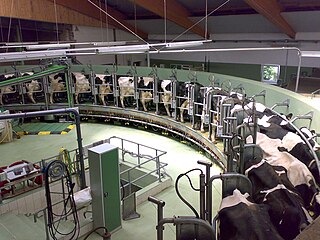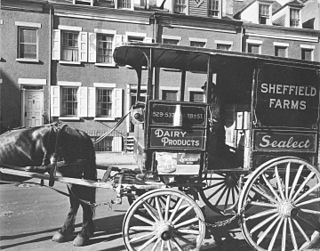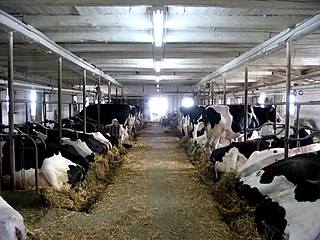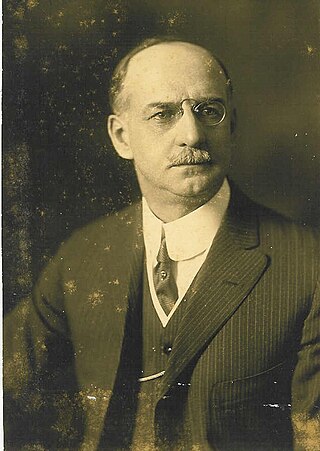Related Research Articles

Milk is a white liquid food produced by the mammary glands of mammals. It is the primary source of nutrition for young mammals before they are able to digest solid food. Immune factors and immune-modulating components in milk contribute to milk immunity. Early-lactation milk, which is called colostrum, contains antibodies that strengthen the immune system and thus reduce the risk of many diseases. Milk contains many nutrients, including protein and lactose.

Pasteurization or pasteurisation is a process of food preservation in which packaged and non-packaged foods are treated with mild heat, usually to less than 100 °C (212 °F), to eliminate pathogens and extend shelf life. The process is intended to destroy or deactivate microorganisms and enzymes that contribute to food spoilage or risk of disease, including vegetative bacteria, but most bacterial spores survive the process.

Infant formula, also called baby formula, simply formula, baby milk or infant milk, is a manufactured food designed and marketed for feeding to babies and infants under 12 months of age, usually prepared for bottle-feeding or cup-feeding from powder or liquid. The U.S. Federal Food, Drug, and Cosmetic Act (FFDCA) defines infant formula as "a food which purports to be or is represented for special dietary use solely as a food for infants by reason of its simulation of human milk or its suitability as a complete or partial substitute for human milk".

Weaning is the process of gradually introducing an infant human or another mammal to what will be its adult diet while withdrawing the supply of its mother's milk.

Dairy farming is a class of agriculture for long-term production of milk, which is processed for eventual sale of a dairy product. Dairy farming has a history that goes back to the early Neolithic era, around the seventh millennium BC, in many regions of Europe and Africa. Before the 20th century, milking was done by hand on small farms. Beginning in the early 20th century, milking was done in large scale dairy farms with innovations including rotary parlors, the milking pipeline, and automatic milking systems that were commercially developed in the early 1990s.

Raw milk or unpasteurized milk is milk that has not been pasteurized, a process of heating liquid foods to kill pathogens for safe consumption and extending the shelf life.

Nathan Straus was an American merchant and philanthropist who co-owned two of New York City's largest department stores, R. H. Macy & Company and Abraham & Straus. He was the namesake for the Israeli city Netanya.
The International Association for Food Protection (IAFP), founded in 1911, is a non-profit association of food safety professionals based in Des Moines, Iowa. The organization claims a membership of over 3,000 members from 50 nations. The mission of the IAFP is to provide food safety professionals worldwide with a forum to exchange information on protecting the food supply.
A human milk bank is "a service which collects, screens, processes, and dispenses by prescription human milk donated by nursing mothers who are not biologically related to the recipient infant". As of November 2019, there are 28 milk banks in North America that are members of the Human Milk Banking Association of North America (HMBANA). They are usually housed in hospitals, although some are free standing. Members of HMBANA follow the annually revised "Guidelines for the Establishment and Operation of a Donor Human Milk Bank" which include protocols for soliciting donors and collecting, processing, and distributing the milk. In addition, some states have required standards for donor human milk banks. However, the Food and Drug Administration (FDA), states that "the FDA has not been involved in establishing these voluntary guidelines or state standards." Some of these protocols are described below.
The United States raw milk debate concerns issues of food safety and claimed health benefits of raw milk, and whether authorities responsible for regulating food safety should prohibit sale of raw milk for consumption.

A human milk bank, breast milk bank or lactarium is a service that collects, screens, processes, pasteurizes, and dispenses by prescription human milk donated by nursing mothers who are not biologically related to the recipient infant. The optimum nutrition for newborn infants is breast milk for at least the first 6 months of life. For women who are unable to breast feed or produce enough milk, pasteurized donor breast milk may be an effective approach to feeding. Breast milk supplied by a woman other than the baby's mother that is not pasteurized and informal breast milk sharing is associated with a risk of transmitting bacteria and viruses from the donor mother to the baby and is not considered a safe alternative. If pasteurized donor breast milk is not available, commercial formula is suggested as a second alternative.

The Sheffield Farms–Slawson–Decker Company, known as Sheffield Farms, was a dairy that pasteurized, bottled, and delivered milk in New York City in the first half of the 20th century. It became one of the largest dairy companies in the world, selling 20% of the city's milk. The company played a major part in transforming commercial milk into a clean and healthy product.

Lactalis is a French multinational dairy products corporation, owned by the Besnier family and based in Laval, Mayenne, France. The company's former name was Besnier SA.

Dairy farming is one of the largest agricultural sectors in Canada. Dairy has a significant presence in all of the provinces and is one of the top two agricultural commodities in seven out of ten provinces.

The Newens Sanitary Dairy Historic District is located in Des Moines, Iowa, United States. It consists of three buildings, the former dairy buildings and the Newens’ family home. The district has been listed on the National Register of Historic Places since 2003.
Mlekara Subotica was a Serbian producer of dairy products based in Subotica, Serbia.
Toned milk is a method, developed in India, of treating buffalo milk by adding skim milk, powdered skim milk and water to buffalo milk. This process decreases the fat content, increases the quantity of available milk, and 'tones up' the non-fat solids level to the original amount. The cost of milk is reduced, making it more widely available and not a luxury purchase.

The swill milk scandal was a major adulterated food scandal in the state of New York in the 1850s. The New York Times reported an estimate that in one year 8,000 infants died from swill milk.

Frank Aydelott Rooke, known professionally as Frank A. Rooke, was a New York architect who designed the historic Claremont Riding Academy and numerous other structures of significance that are either in National Historic Districts or listed on the National Register of Historic Places in the tri-state area.
Agriculture is a major component of the New York economy. As of the 2012 census of agriculture, there were over 35,000 farms covering an area of 7 million acres (28,000 km2) which contributed $5.4 billion in gross sales value and $1.2 billion in net farm income to the national economy. Dairy farming alone accounted for $2.5 billion or 45% of sales. The Finger Lakes region is the center of state agriculture, and the state is a top-ten national producer of cow milk, apples, grapes, onions, sweet corn, tomatoes, and maple syrup. New York places second in apples next to Washington.
References
- ↑ Current Biography 1940, p344
- ↑ Albert Joseph Kennedy and, Robert Archey Woods, The Settlement horizon: A National Estimate (Russell Sage Foundation, 1922)
- ↑ John Spargo, "The Political Economy of Saving Babies' Lives: Practical Method of Improving Cities' Milk Supply", in The Craftsman, by Gustav Stickley, pp. 301-314 (The United Crafts, 1907) Retrieved from Google book search, July 24, 2007